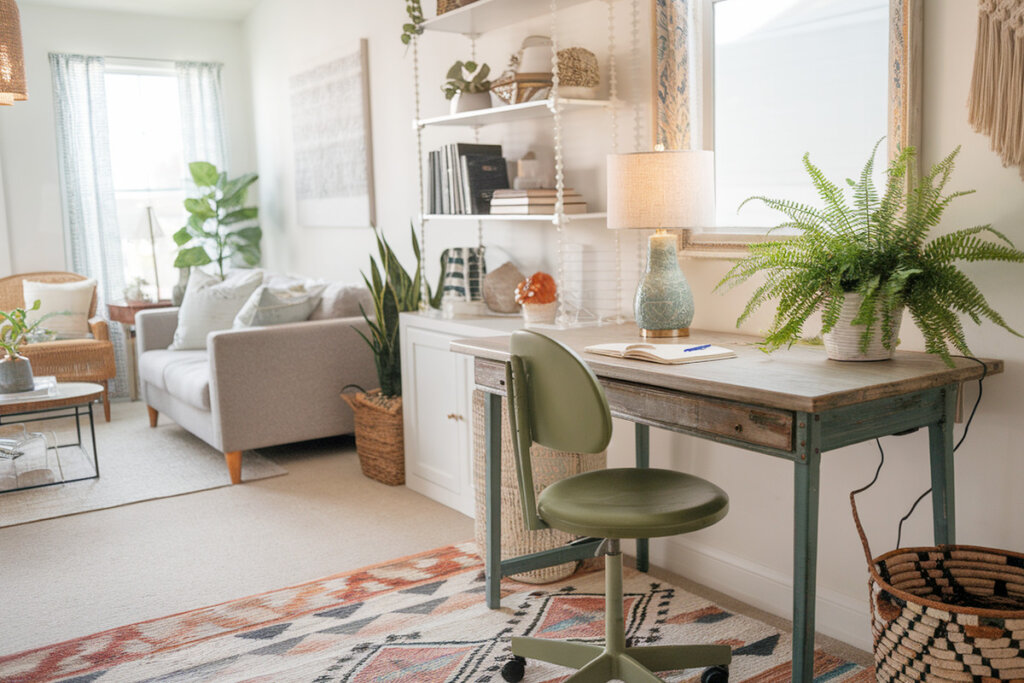Working from home solves a multitude of problems while improving business efficiency and productivity.
However, for this model to work, you need the right resources, which begins with a dedicated place for your work projects. It can be a challenge if you live in a shoebox — but it’s not impossible.

Here’s your crash course on how to create an office space in a small home.
Why You Need a Dedicated Office Space
Although telecommuting makes it easier to toss in a load of laundry on your breaks, it can also make your work and home life bleed together uncomfortably.
You can start feeling as if you never leave the office, which can increase anxiety and decimate your productivity.
A dedicated home office space creates a necessary compartmentalization between your work and home life.
When your day ends, you can shut the door on your labor, quite literally in some cases.
Even if you don’t have a complete room but a portion of one, devoting that area to work and work alone provides a sense of arriving at and going home from the office that eases stress and helps you focus on one task at a time.
4 Ways to Create Office Space in a Small Home
Fortunately, there’s a world of options for creating office space in a small home if you get creative. Here are some ideas to ignite your spark.
1. Repurpose a Closet
Who said you needed an entire room for your home office?
Think about it — the average cubicle is roughly the same size as many closets.
Repurposing one of your storage spaces into an office provides the advantage of literally closing the door on work at day’s end, but that’s not the only perk.
Many closets provide shelf space or you could benefit from a floating desk.
You may not have to build storage for your files and reference books when you have a ready-made set. Do you have noisy roommates or kiddos?
Acoustic panels cost relatively little and can provide a serene, silent space for handling conference calls, even when your little ones are home on break.
Repurposing a closet is also a wise choice if you work in an industry with strict privacy rules.
For example, accountants must keep client financial documents behind lock and key, which is easier to do with a door. Those in health care can handle confidential conversations without extra ears listening in.
Be creative if cramped. If you have little horizontal but a ton of vertical space, can you mount a high-hanging bar for your clothes with space for a desk underneath?
Adding a shoe rack to the back of your closet door clears up floor space for your work area.
Investing in stackable storage crates lets you stash accessories like purses, belts and seasonal items to create more room.
2. Partition a Room
If you don’t have a closet to spare, you can create an extra room with a partition.
The most elaborate way to make an office space in your small home would be to add a full interior wall with a door connecting the two areas.
However, going floor-to-ceiling might not be your preference if your rooms are already tiny.
A pony wall is another option that preserves openness while providing a divided space.
You can save additional room by choosing a model with built-in shelves or designing your DIY build to include them.
Indenting them into the wall saves even more space and keeps you from hitting your shins — be sure to round the corners of protruding shelves.
A tension rod can also provide an inexpensive partition in a pinch, and you can use it atop a pony wall to create a private space during working hours, removing it when the day ends.
You can also install a track for vertical blinds above your half-wall.
Yet another way to create office space is to invest in a folding divider.
Although they don’t do much to block sound, they can separate the area, providing a vital division between the workday and relaxation for those who live alone and have no need to drown out the surrounding din.
3. Hunt High and Low
Attics with low ceilings might be quite comfortable when seated at your desk.
Measure your area and reinforce the floor to build your private space. Place it near a vent for a bit of natural light, or add a window if your space lacks one and you have the cash.
As a bonus, an attic home office quickly tells you if your home needs more insulation, as temperatures can vary widely without it.
Supplement yours if necessary, although you may still need a climate control solution like a space heater or fan in extreme weather.
Your basement offers privacy and consistent year-round temperatures, although it can be damp and dark. Hang mirrors across from any windows to spread more light around the space.
Use bright LEDs with a dimmer to help your body transition from day to night if you must rely on artificial light sources. Consider installing carpet underfoot to keep your toes toastier.
4. Go Outside and Wide
If you have a small home but a yard, you could create office space on an existing enclosed deck or patio. Another option is an outbuilding, such as a converted shed or a prefab tiny home you can find on sites like Amazon.
While the latter is the more expensive option, it also offers the world’s most pleasant commute.
You can even craft one out of scrap materials if you’re handy, sparing them from the landfill while saving money. If you choose to create office space in an outdoor living area you also use for recreation, employ a tactic or two listed above to partition a portion for work purposes.
Making Office Space in a Small Home
Having a dedicated office is a must for folks who telecommute.
It creates a necessary divide between your work and home life, easing your stress levels so you can maintain your productivity and focus.
A little creative thinking lets you create an office space in any home so you can flourish in your career.



Leave a Reply